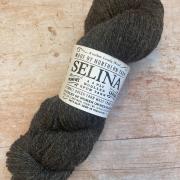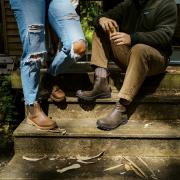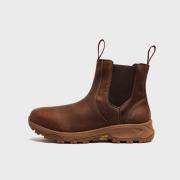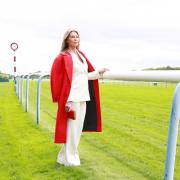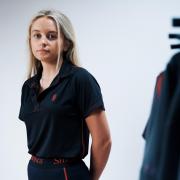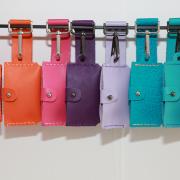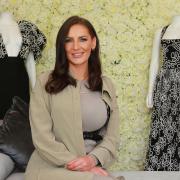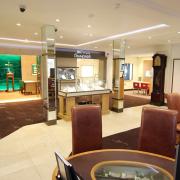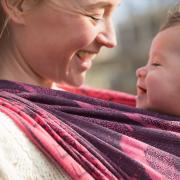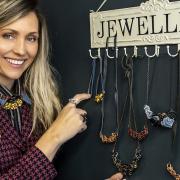A couple in Parbold are reviving the glory days for a textile firm that boomed in the 1950s design revolution. Sue Riley reports

IN the 1950s it was one of Lancashire’s success stories, selling contemporary textiles around the globe and employing tens of thousands of people. David Whitehead & Sons was a name for cutting edge design with its name linked to some of the UK’s top avant-garde artists including Terence Conran and the sculptor Henry Moore. Like much of East Lancashire’s textile industry, its mills have now been converted to luxury flats and the Whitehead name all but died out. Until now.
Husband and wife team Bernard Laverty and Jill Worrall have spent tens of thousands of pounds researching the company’s history and have just re-issued six original designs to mark its 200th anniversary. ‘We didn’t really know what we were buying,’ said Bernard, who purchased the company name in 1996 after working as the financial director for then owners, Lonrho. It was only when he was looking through the leather-bound company ledgers that he discovered the firm’s fascinating history in the Rossendale Valley and the abstract designs they produced piqued Jill’s interest.
‘We knew we had bought something with a bit of history, we can go back to 1833 and have films from the 1940s and 1950s showing how the textiles were made and the children of the workers going to Lytham for the day. We believe we had one of the first, if not the first, workplace nurseries,’ said Jill.
There was just one problem – they didn’t own a single scrap of original Whitehead fabric. Many of the original designs are in the Victoria & Albert Museum, the Whitworth in Manchester and the Geffrye Museum in London which all have extensive archives, so Jill started scouring the internet. Soon they had amassed hundreds of pieces of fabric, mainly curtains.
‘Some of them were so moth-eaten I had to put them in the freezer, they were rammie, really grubby!’ said Jill. After choosing half a dozen designs by prolific Austrian artist Marian Mahler and Jacqueline Groag, they have now digitised them with the help of Irish artist Keith Armstrong and are in the process of having them printed again.
‘They are the designs but with the weave removed, so they look cleaner,’ said Bernard. They have also insisted that they should still be made in Lancashire and small quantities of the furnishing fabrics are being printed at Lancaster’s Standfast & Barracks. That’s as far as the couple have got, but are hoping one of the major design museums may want to stock them or liaise on future projects, including reproducing some 1960s designs by Henry Moore and John Piper.
‘These are not just museum pieces, it’s being made by the original company. It was very important to me that they were printed in Lancashire too,’ said Jill, who lives in Aughton. ‘The David Whitehead story deserved to be told and if something good comes out it that would be fabulous,’ said Jill, adding that they paid between £30 and £800 for the samples.
In its heyday David Whitehead & Sons was run by brothers David, Peter and Thomas Whitehead in Rawtenstall and used to make red canvas for circus families and also produced millions of yards of industrial denim and even supplied the material to the 1957 Polar expedition.
Although only one mill remains in the town today, the Ilex Mill is now turned into flats, the firm’s impact endures with Whitehead Street and oil paintings in the local gallery capturing the mills at the height of the Industrial Revolution. The firm was at the height of its popularity just after it exhibited at the Festival of Britain in 1951 where its modern designs caught the public’s imagination and sold well around the globe.
The firm – which had the maxim ‘cheap need not be cheap and nasty’ – also had a shop in London’s Regent Street. It’s those colourful designs that Jill is hoping will revive the company’s popularity.
‘I absolutely love it, the designs and the history. We were watching Who Do You Think You Are on TV and Lancashire actress Jane Horrocks visited Rawtenstall because her Auntie Molly worked in the office at the Whitehead Mill. We knew there was a strong heritage but we just keep finding out more information,’ she said.
On a recent visit to Tate Liverpool Bernard saw some wrapping paper in the shop which was an original Whitehead design. Similarly, the V & A in London has tea towels and mugs on sale with the Whitehead designs. Bernard and Jill hope their popularity bodes well for their own designs which were launched at an anniversary event at Windermere Motor Boat Racing Club in the Lake District. Guests included Jane Horrocks’ mother and auntie.
It’s a far cry from 1996 when Bernard purchased the company, saying the only thing he bought was goodwill, an office in Burnley, 12 employees, no contracts, and the David Whitehead name. Over the years the team has reduced to Bernard and two part-time employees who sell textile sundries. Bernard, a chartered accountant, is also a partner in an accountancy firm based in his offices in the former NatWest Bank in Parbold.
He moved the firm to Parbold shortly after buying the company and all the firm’s minute books dating back to the 19th century are kept in the bank vault.
Proud of the history they have bought and not knowing how the design aspect of their business will take off, they have also produced a few mugs featuring the designs which they will sell via their website. ‘I will be on Ormskirk Market selling them for £1 if it all goes wrong,’ laughed Jill.




